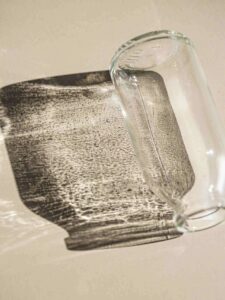This article will introduce a type of bottle mouth defect: the treatment method for indentations on the inner surface of the bottle mouth. This defect, also known as a “dish-shaped mouth” by some factories, appears as an inward slope when viewed obliquely from the plane of the bottle mouth. Due to the slanted plane of the mouth, the seal becomes less effective when a cap is applied, leading to gas leakage. This issue requires special attention, as it has previously caused serious complaints, bringing many troubles to production and customers. Additionally, slightly indented bottle mouths are difficult for automatic inspection machines to detect and remove, making it necessary to eliminate this defect during the bottle manufacturing process.

1. Causes
Understanding the reasons behind the indentation on the inner surface of the bottle mouth is crucial for preventing and addressing this defect. The primary cause of these indentations is the poor formation of the bottle mouth. Specifically, performing the blowback operation while the mouth is not fully solidified can easily lead to deformation. This incomplete solidification makes the bottle mouth susceptible to indentation, causing the seal to be less effective and leading to potential gas leakage.
2. Countermeasure Basis
To ensure good formation of the bottle mouth, attention needs to be paid to the following five key elements:
○ Material
○ Equipment
○ Mold
○ Process
○ Management
The key elements of the forming process include:
○ Material drop temperature
○ Material drop shape
○ Mold temperature
○ Forming pressure
○ Timing
For each product defect, if the above elements are systematically checked and eliminated from largest to smallest, the main cause can quickly be identified and effective countermeasures proposed. Conversely, by establishing good production conditions based on these countermeasures, defects can be prevented in advance.
3. Process Causes
Indentations on the inner surface of the bottle mouth may be caused by the following process issues:
○ Material drop temperature too high
○ Material drop is short and thick with a large head
○ Slow material drop speed
○ Low blow pressure, short blow time
○ Blowback operation too early or too high pressure
The control of temperature during the forming process of the bottle mouth is crucial. Additionally, the length of the material drop must be considered, and conditions for smooth material drop creation must be ensured.
4. Mold Causes
Improper mold design can also lead to indentations on the inner surface of the bottle mouth, for example:
○ Small radius at the front end of the plunger, plunger too long, no vent groove
○ Poor vent design of the mouth mold, leading to poor ventilation
5. Equipment Causes
Equipment issues can also cause bottle mouth indentations, such as:
○ Plunger delay on OFF (delayed descent), leading to high plunger temperature, reduced gap between the plunger and sleeve, increased blowback airflow velocity, and increased impact on the mouth
6. Professional Advice
For questions such as how to determine if the material drop temperature is too high, the blow pressure is too low, or the plunger is too long, it is necessary to perform more on-site operations, measure data, improve observational skills, accumulate experience, and form standards. We welcome you to follow us or contact our professionals for more industry knowledge and information.
By systematically analyzing and addressing this defect of indentation on the inner surface of the bottle mouth using the methods above, product quality can be effectively improved, customer complaints can be reduced, and the company’s reputation can be enhanced.











